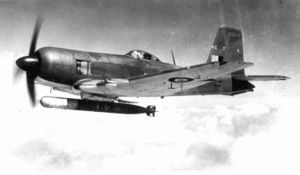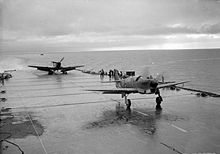Blackburn Firebrand Videos - Picture

|
|
Blackburn Firebrand
Firebrand

Picture - Centaurus IX-powered Firebrand TF Mk. IV.
Role: Strike fighter
Manufacturer: Blackburn Aircraft
Designed by: G. E. Petty
First flight: 27 February 1942
Introduced: 1943
Retired: 1953
Primary user: Fleet Air Arm
Produced: 1942-1947
Number built: 193
Variants: B-48 Firecrest
The Blackburn Firebrand was a single-engine fighter aircraft designed to Air Ministry Specification N.11/40 by Blackburn Aircraft. It was designed around the Napier Sabre III 24-cylinder H-type engine as a single-seat fleet fighter for the Royal Navy.
Development
Work on the B-37 Firebrand proceeded slowly. An unarmed prototype first flew on 27 February 1942, the armed Firebrand F Mk. I second prototype flying on 15 July of that year. The Sabre engine was also used in the Hawker Typhoon, a fighter already nearing production, and was earmarked for that aircraft. A new engine was needed, along with airframe improvements to handle it; along with these modifications it was deemed appropriate to convert the Firebrand into a strike fighter capable of carrying torpedoes, bombs, and rockets as well as engaging in air to air combat. Only nine production F Mk. I aircraft were built. The Firebrand was unusual in that there was an airspeed gauge mounted outside of the cockpit so that during landing the pilot would not have to look down into the cockpit to take instrument readings, presaging the development of the modern heads up display.
By the time service trails were ongoing the Fleet Air Arm was operating the Supermarine Seafire as a carrier-borne fighter and a new role as a torpedo-bomber was envisaged for the Firebrand. The first strike variant, the Firebrand TF Mk. II (B-45), flew on 31 March 1943, and was an adaptation of the Mk. I. It incorporated slightly wider wingspan that allowed carriage of a torpedo between the retracted main landing gear. Like the Mk I, the TF Mk. II only saw a very limited production of 12, and was followed by the Firebrand TF Mk. III with the Bristol Centaurus VII radial engine. After the first flight on 21 December 1943, problems arose: the new engine produced more torque than the Sabre, and rudder control was insufficient on takeoff. The TF Mk. III was determined to be unsuitable for carrier operations, and work began on an improved airframe that would be better-suited for the Centaurus. The aircraft had killed two test pilots and, although after six months' modification Dennis Cambell did manage the first successful deck landing, the type was generally regarded as one of the war's worst aircraft.
The Firebrand TF Mk. IV (B-46), as the new development was designated, featured a newer Centaurus IX engine and larger tail surfaces for better low-speed control. The enlarged rudder was horn balanced, and the wings now featured dive brakes on both upper and lower surfaces. The TF Mk. IV first flew on 17 May 1945, and was the first version of the Firebrand to enter mass production, with 102 built. The later Firebrand TF.5 featured minor aerodynamic improvements and was also built in large numbers, with 68 entering service. A further 40 TF Mk. IVs were converted to the TF.5 standard.
The final production version was the Firebrand TF Mk. 5A.
A proposal to fit floats was designated as the Blackburn B-43 by the company, to be used for fighter defence for areas without room for an airfield, the idea was dropped.
Operational history

Picture - A Fairey Firefly takes off from HMS Illustrious in the River Clyde in 1943. In the background a Sabre-engined Firebrand Mk.II is running up its engine on the deck lift.
The Firebrand did not see action in the Second World War, but it remained in front-line service on Royal Navy carriers until 1953.
Operators
United Kingdom
Royal Navy Fleet Air Arm
700 Naval Air Squadron
703 Naval Air Squadron
708 Naval Air Squadron
736 Naval Air Squadron
738 Naval Air Squadron
759 Naval Air Squadron
764 Naval Air Squadron
767 Naval Air Squadron
778 Naval Air Squadron
787 Naval Air Squadron
799 Naval Air Squadron
813 Naval Air Squadron
827 Naval Air Squadron
Specifications (Firebrand TF Mk. IV)
Data from Jane's Fighting Aircraft of World War II
General characteristics
Crew: One pilot
Length: 39 ft 1 in (12 m)
Wingspan: 51 ft 3½ in (15.62 m)
Height: ft in (m)
Wing area: 381.5 ft² (35.44 m²)
Empty weight: 11,357 lb (5,150 kg)
Loaded weight: 15,671 lb (7,100 kg)
Max takeoff weight: 16,227 lb (7,360 kg)
Powerplant: 1x— Bristol Centaurus IX 18-cylinder radial engine, 2,500 hp (1,865 kW)
Performance
Maximum speed: 350 mph (300 kn, 560 km/h)
Cruise speed: 289 mph (251 kn, 465 km/h) at 10,000 ft (3,050 m)
Stall speed: 75 mph (65 kn, 121 km/h)
Range: 1,250 mi (1,100 nmi, 2,000 km) with torpedo and drop tanks
Rate of climb: 2,600 ft/min (13.2 m/s)
Wing loading: 41.7 lb/ft² (203.6 kg/m²)
Power/mass: .157 hp/lb (347 W/kg)
Armament
Guns: 4x— 20 mm (0.79 in) Hispano Mk.II cannon, two in each wing
Bombs:
1 x— 1,850 lb (840 kg) 18 in (457 mm) Mark XVII torpedo, or
2 x— 1,000 lb (454 kg) bombs, one under each wing, in place of torpedo
Related development
Blackburn Firecrest
Comparable aircraft
Boeing XF8B
Curtiss XBTC
Douglas A-1 Skyraider
Douglas XTB2D Skypirate
Fairey Spearfish
Westland Wyvern
Bibliography
Brown, Eric, CBE, DCS, AFC, RN.; Green William and Swanborough, Gordon. "Fairey Swordfish". Wings of the Navy, Flying Allied Carrier Aircraft of World War Two. London: Jane's Publishing Company, 1980, p. 157-167. ISBN 0-7106-0002-X.
Buttler, Tony. Blackburn Firebrand - Warpaint Number 56. Denbigh East, Bletchley, UK: Warpaint Books Ltd., 2000.
Jackson, A.J. Blackburn Aircraft since 1909. London:Putnam, 1968. ISBN 0 370 00053 6.
Mondey, David. The Hamlyn Concise Guide to British Aircraft of World War II. London: Chancellor Press, 1982. ISBN 1-85152-668-4.
Blackburn Firebrand Pictures and Blackburn Firebrand for Sale.
Living Warbirds: The best warbirds DVD series.
Source: WikiPedia